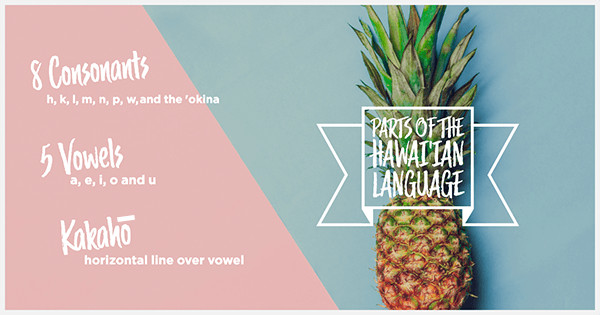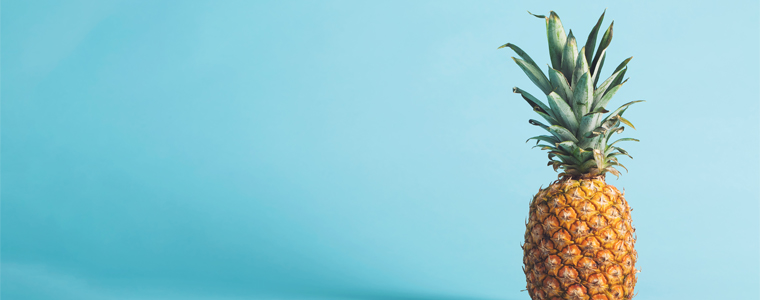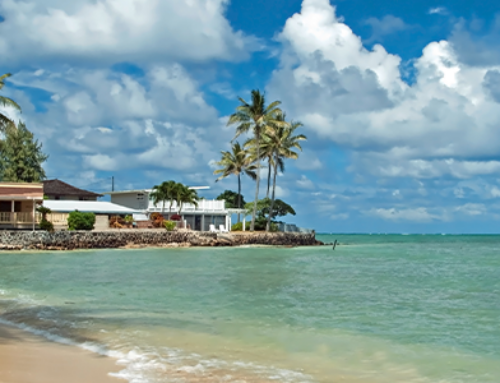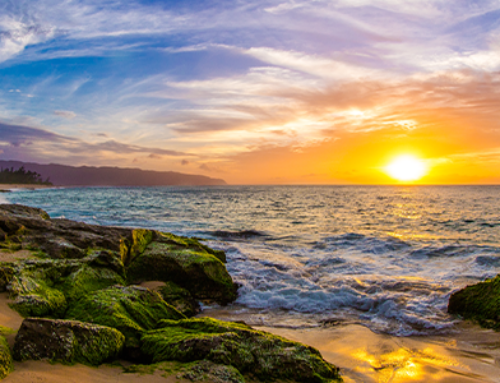One of the things we love about moving people to new destinations is sharing insider information and answering questions. When customers move from the Mainland to Hawaii, we often get the following queries:
- “What’s the right way to say Hawai’i? Is it ha-WHY? Or ha-WHY-ee?”
- “And, wait, is it ha-WHY-ee or ha-VAI-ee?”
- “Oh, and what does the apostrophe-like mark mean in Hawai’i and O’ahu?”
That little mark is called the ‘okina, and it’s actually an official consonant in the Hawaiian language. It represents what’s called a glottal stop. To practice pronouncing the ‘okina, say the word “uh-oh.” That break between the syllables where your throat closes is the same kind of break you’ll insert where you see an ‘okina.
Not only does the ‘okina change the pronunciation of a word, but it can also change the meaning. For example, kou means “yours” and ko’u means “mine.” Similarly, moa refers to a chicken while mo’a means cooked.
So if you want to pronounce Hawai’i like a native Hawaiian, say: ha-VAI-ee—and don’t forget that glottal stop before the last i. (More on the V/W question in a moment!)
And if you want to learn a little more about the history of the language that belongs to your new home, read on!
Note: If you look through our other articles, you’ll notice that we don’t use the ‘okina unless it affects the meaning of a word, with the exception of this article. Would you rather see us include it? Leave us a note in the comments section at the end of the article!
Where Did the Hawaiian Language Come From?
The answer to this question might seem simple, that the Hawaiian language came from the people who made the island their home. However, the story of the language we call “Hawaiian” today is a little more complex. Like much of modern-day Hawai’i, the language of the Hawaiian people was shaped strongly by foreign visitors to the island.
Before Christian missionaries arrived in the early 19th century, the Hawaiian language, or ‘Olelo Hawai’i, was an entirely oral one. It belongs to the same family as the other languages found in Polynesia. In fact, when Captain James Cook visited the Hawaiian islands in the late 18th century, he was able to use words from both Tahitian and Maori to communicate with the Hawaiians.
Because the Christian missionaries wanted to share their religion with the Hawaiians, one of their first tasks was translating the Bible into Hawaiian. For that, they needed to create a written version of the Hawaiian language.
Out of that project, the written Hawaiian language was born. After a few revisions, it now consists of 3 components:
- 8 consonants: h, k, l, m, n, p, w and the ‘okina (officially counted as a consonant)
- 5 vowels: a, e, i, o, u
- The kakahō, a horizontal line that appears over a vowel to add stress and length to a vowel.

Because the missionaries were not linguists, the written language they created didn’t perfectly capture the native Hawaiians’ pronunciation. For example, look at the original pronunciation of Honolulu, which was closer to “Honoruru.” More on this shortly when we talk about the famous ha-WHY-ee vs. ha-VAI-ee debate.
But, first, let’s take a quick look at where the Hawaiian language stands today.
The Hawaiian Language in Modern Times
Although it has bounced back in recent years, UNESCO still lists Hawaiian as “critically endangered,” with fewer than 2,000 speakers.
After the annexation of the islands, the United States passed a law in 1896 requiring all schools to teach in English. Although the law didn’t strictly forbid speaking Hawaiian in school, Children who spoke the language in school were often punished. As a result of these oppressive practices, the number of native speakers dwindled considerably.
In recent years, interest in preserving Hawaiian culture and language has emerged. In 1978, Hawaiian was reinstated as the official language of the state. Additionally, Hawaiian language immersion programs have been established, starting with the Punana Leo (Nest of Voices) schools, which have received federal funding for the last 20 years.
The Hale Kuamo’o Hawaiian Language Center at the University of Hawai’i at Hilo has also strongly supported the continued revival of the language. In addition to contributing to ongoing scholarly research, the center offers a master’s degree in Hawaiian language and literature taught exclusively in Hawaiian.
Finally, the Hawaii Board on Geographic Names is also going through the USGS maps and restoring ‘okina and kahako where appropriate. As a result, maps and signage will reflect proper historical names going forward, continuing to restore the Hawaiian language to prominence.
But What’s the Deal with the Ws and the Vs?
Now that you understand the ‘okina, you may still find yourself wondering whether it’s ha-WHY-ee or ha-VAI-ee—and the answer is a little complicated.
As you’ll recall, the original missionaries to Hawaii were unable to accurately capture Hawaiian pronunciation for many of its consonants. The W is no exception.
First, let’s look at the way Americans pronounce their Vs and Ws. When you say “violet,” your bottom lip and top teeth come into contact. However, when you say “water,” the sound comes from the contact of your lips only. (Try it!)
Hawaiians don’t use really have a V and a W. Instead, they have a hard W that sounds like a V and a soft W that sounds like a W. However, their teeth are not used to make either sound.
Can you start to see how easy it could be for the missionaries to miss the mark on translating Hawaiian to a written language? It’s these kinds of subtleties that we count on trained linguists to point out.
Additionally, when a W falls after an A, there is no hard-and-fast rule for whether the sound should be a hard W (ha-VAI-ee) or a soft W (ha-WHY-ee). Many argue for the V pronunciation, while others say it can sound a bit, well, affected—especially coming out of the mouth of a Mainlander.
Your best bet? Focus on the ‘okina! Master making it feel natural, then venture into the great ha-WHY-ee vs. ha-VAI-ee debate.

Even better: Ask your new friends and neighbors what they do, and you’ll likely learn a lot about the people and culture that surrounds you.
Settling into Your New Home
Pronouncing many of the new places you’ll discover in Hawai’i takes a little bit of practice. (Wait until you encounter our state fish, the humuhumunukunukuapua’a!)
However, now that you understand the ‘okina and what it represents, you’re well on your way to pronouncing place names like a seasoned islander. Don’t be afraid to ask around for help. It might be the start of a new friendship that makes your island life feel even homier.
If we can help in making Hawai’i your home, don’t hesitate to reach out to us. Our Certified Moving Consultants would be happy to help you move all the comforts of home to your new island locale. (And they’d be happy to tell you whether they fall in the ha-WHY-ee or ha-VAI-ee camp!)
Tell us about your move!



